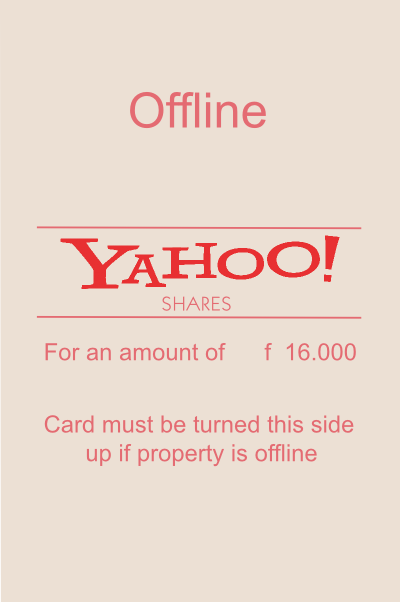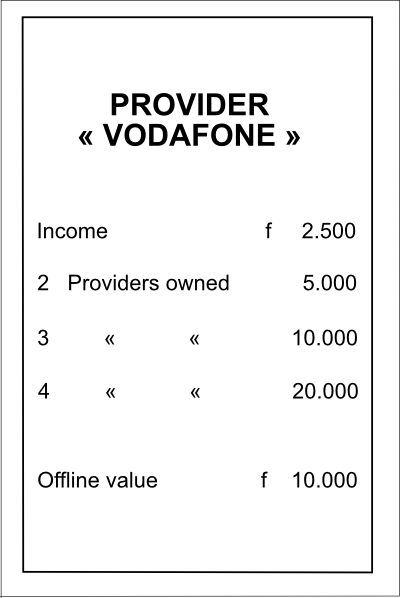User:Fako Berkers/WWWonopoly: Difference between revisions
Fako Berkers (talk | contribs) |
Fako Berkers (talk | contribs) |
||
| (11 intermediate revisions by the same user not shown) | |||
| Line 1: | Line 1: | ||
== | ==Final version== | ||
===Description:=== | |||
A lot has changed since the last time I wrote about it. There were different iterations and I tried out a few things after which I ended up with this final version. To give an idea of what I tried: | |||
* different lay outs for the board | |||
* different setups for the card system ranging from add-ons to in-site solutions | |||
* different outcomes, I tried to add some animation to what people see on the screen, but decided against it in the end, because it would distract from what I wanted to communicate | |||
* the content on the chance/community cards have changed quite a bit as privacy news came in (like LinkedIn) | |||
* all money is in dollars instead of florijnen | |||
* after a test game it turned out that the gameplay needed to change, since people wouldn't interact with the screens if text were on the cards themselves | |||
* deciding for SVG turned out to be double work, because for print everything needed to be redone in Illustrator format | |||
===Some important considerations:=== | |||
* I decided to go for two screens, because I wanted to convey that although I'm manipulating one screen the other screen is "simply a browser" | |||
* Keeping the complexity of telling a story about tracking was important for me, because I'm a storyteller, not a graphic designer. Keeping that element was essential to what made it my work and I think the (emotional) experience that people had with the game confirm that it worked as a story telling medium. | |||
===Credits:=== | |||
* I was greatly helped by Dennis van Vreeden and Barend Onneweer to get some important visual elements in place. | |||
===Files:=== | |||
* [http://pzwart3.wdka.hro.nl/ | * [http://pzwart3.wdka.hro.nl/~fberkers/WWWonopoly_image_files.zip An archive with all imagery] | ||
* | * [http://pzwart3.wdka.hro.nl/~fberkers/WWWonopoly_3d_files.zip An archive with all 3D models] | ||
* | * [http://pzwart3.wdka.hro.nl/~fberkers/WWWonopoly_software_files.zip An archive with all software (full Django project)] | ||
==Visuals== | ==Visuals== | ||
| Line 79: | Line 92: | ||
==Why== | ==Why== | ||
It lies in our nature that we can't assess risks very well. A lot of people like social media, but very few seem to be aware what the risks of them are. By allowing players to take the perspective of somebody with power over the functioning of the social media system, the players get a bird view of what is happening. From this perspective the players are more likely to become aware of risks than when they have a frog like perspective on social media by interacting with the platforms. By playing the game and reading the bits of text and articles that are attached to each game message, the player gets a better sense of how social media function and in which way the player is vulnerable on line. Informing users in this somewhat playful manner lie could prevent harm. | It lies in our nature that we can't assess risks very well. A lot of people like social media, but very few seem to be aware what the risks of them are. By allowing players to take the perspective of somebody with power over the functioning of the social media system, the players get a bird view of what is happening. From this perspective the players are more likely to become aware of risks than when they have a frog like perspective on social media by interacting with the platforms. By playing the game and reading the bits of text and articles that are attached to each game message, the player gets a better sense of how social media function and in which way the player is vulnerable on line. Informing users in this somewhat playful manner lie could prevent harm. | ||
==Card system== | |||
Whenever people have to draw a community chest or change card, people will have to swipe that card over a RFID scanner. This scanner will make sure that the card is shown on a big screen together with the news article that inspired the text on the card. | |||
You can go to this link to see a prototype in action: | |||
* [http://pzwart3.wdka.hro.nl/django/fberkers/wwwonopoly wwwonopoly card system] | |||
* Once there you have to type which card you want to see at the moment. | |||
* First you have to type which kind of card you want to see by typing "ch" (for change) or "cc" (for community chest) without quotes. | |||
* Typing the kind of card should be followed by typing a number between 1 and 16. | |||
* After this press enter and the card will show up! | |||
* Example: typing "cc9" (without quotes) followed by enter will bring up commmunity chest card number 9 | |||
Latest revision as of 20:23, 30 July 2012
Final version
Description:
A lot has changed since the last time I wrote about it. There were different iterations and I tried out a few things after which I ended up with this final version. To give an idea of what I tried:
- different lay outs for the board
- different setups for the card system ranging from add-ons to in-site solutions
- different outcomes, I tried to add some animation to what people see on the screen, but decided against it in the end, because it would distract from what I wanted to communicate
- the content on the chance/community cards have changed quite a bit as privacy news came in (like LinkedIn)
- all money is in dollars instead of florijnen
- after a test game it turned out that the gameplay needed to change, since people wouldn't interact with the screens if text were on the cards themselves
- deciding for SVG turned out to be double work, because for print everything needed to be redone in Illustrator format
Some important considerations:
- I decided to go for two screens, because I wanted to convey that although I'm manipulating one screen the other screen is "simply a browser"
- Keeping the complexity of telling a story about tracking was important for me, because I'm a storyteller, not a graphic designer. Keeping that element was essential to what made it my work and I think the (emotional) experience that people had with the game confirm that it worked as a story telling medium.
Credits:
- I was greatly helped by Dennis van Vreeden and Barend Onneweer to get some important visual elements in place.
Files:
- An archive with all imagery
- An archive with all 3D models
- An archive with all software (full Django project)
Visuals
What
My project at first glance looks like a regular Monopoly game. However the streets don't represent streets in Atlantis City or any other city in the world. Instead they portray internet platforms like Facebook, Hotmail, Youtube and Twitter. Therefor it is impossible to buy streets in this game, but it is possible to buy shares, bonds of derivates from these web services. Similarly you can't buy houses or hotels, but you're able to buy data storage and data centers. When players draw a “change” or “community chest” card they tell stories about how social media are leaking data about their users and how people are affected by this.
How
For now I limit my description of how to: a table that states how each element in the original Monopoly game will get restyled to fit the new game reality I want to create.
| Monopoly | WWWonopoly |
|---|---|
| Change cards | Messages about data leaks |
| Community chest cards | Messages about data leaks |
| Landing on electricity and water company | Draw a change or public fond card |
| Buying/landing on/trading a street | Buying/landing on/trading shares, bonds or derivates of a platform |
| Completing streets of a color | Owning a platform |
| Buying houses | Buying data storage |
| Buying hotels | Buying data centers |
| Buying/landing on a railway station | Buying/landing on an internet provider |
| Get salary | Get salary |
| Go to prison | You caught a computer virus! Go to quarantine. |
| Pay taxes | Only two things are sure in life: death and ... ;) |
| Free parking | Free peer-to-peer downloads |
| Take a mortgage on property | Putting a platform offline |
A few rules that are nice to add here:
- There is no such thing as the free p2p download jackpot (as the game would last forever)
- Each player begins with two randomly assigned properties for which they must pay (to speed up play)
- A game will last X number of turns
Why
It lies in our nature that we can't assess risks very well. A lot of people like social media, but very few seem to be aware what the risks of them are. By allowing players to take the perspective of somebody with power over the functioning of the social media system, the players get a bird view of what is happening. From this perspective the players are more likely to become aware of risks than when they have a frog like perspective on social media by interacting with the platforms. By playing the game and reading the bits of text and articles that are attached to each game message, the player gets a better sense of how social media function and in which way the player is vulnerable on line. Informing users in this somewhat playful manner lie could prevent harm.
Card system
Whenever people have to draw a community chest or change card, people will have to swipe that card over a RFID scanner. This scanner will make sure that the card is shown on a big screen together with the news article that inspired the text on the card.
You can go to this link to see a prototype in action:
- wwwonopoly card system
- Once there you have to type which card you want to see at the moment.
- First you have to type which kind of card you want to see by typing "ch" (for change) or "cc" (for community chest) without quotes.
- Typing the kind of card should be followed by typing a number between 1 and 16.
- After this press enter and the card will show up!
- Example: typing "cc9" (without quotes) followed by enter will bring up commmunity chest card number 9





